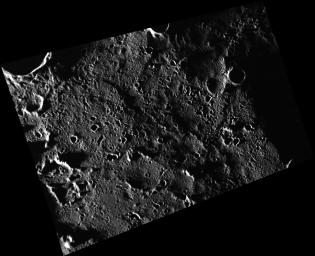
|
Sunlight Near the North Pole
- Click the image above for a larger view
- Full-Res JPEG (972 x 790) (98.3 kB)
- Full-Res TIFF (972 x 790) (768.9 kB)
Caption:
This image was taken with an extremely high incidence angle, indicating that the depicted surface is close to the terminator . Unlike a low incidence angle, at which color observations are optimal, a high incidence angle highlights surface morphology. The image was taken relatively near the north pole of Mercury, a region that receives little sunlight.
This image was acquired as part of MDIS's high-resolution surface morphology base map. The surface morphology base map will cover more than 90% of Mercury's surface with an average resolution of 250 meters/pixel (0.16 miles/pixel or 820 feet/pixel). Images acquired for the surface morphology base map typically have off-vertical Sun angles (i.e., high incidence angles) and visible shadows so as to reveal clearly the topographic form of geologic features.
Date acquired:
June 19, 2011
Image Mission Elapsed Time (MET):
216930156
Image ID:
396833
Instrument:
Wide Angle Camera (WAC) of the Mercury Dual Imaging System (MDIS)
WAC filter:
7 (748 nanometers)
Center Latitude:
85.74°
Center Longitude:
253.1° E
Resolution:
163 meters/pixel
Scale:
This image is approximately 125 km (78 mi) across
Incidence Angle:
88.7°
Emission Angle:
46.9°
Phase Angle:
135.6°
Background Info:
These images are from MESSENGER, a NASA Discovery mission to conduct the first orbital study of the innermost planet, Mercury. For information regarding the use of images, see the MESSENGER image use policy .
Cataloging Keywords:
| Name | Value | Additional Values |
|---|---|---|
| Target | Mercury | |
| System | ||
| Target Type | Planet | |
| Mission | MESSENGER | |
| Instrument Host | MESSENGER | |
| Host Type | Orbiter | |
| Instrument | Mercury Dual Imaging System (MDIS) | |
| Detector | Wide Angle Camera (WAC) | |
| Extra Keywords | Grayscale, Map, Shadow | |
| Acquisition Date | ||
| Release Date | 2011-07-11 | |
| Date in Caption | 2011-06-19 | |
| Image Credit | NASA/Johns Hopkins University Applied Physics Laboratory/Carnegie Institution of Washington | |
| Source | photojournal.jpl.nasa.gov/catalog/PIA14397 | |
| Identifier | PIA14397 | |
